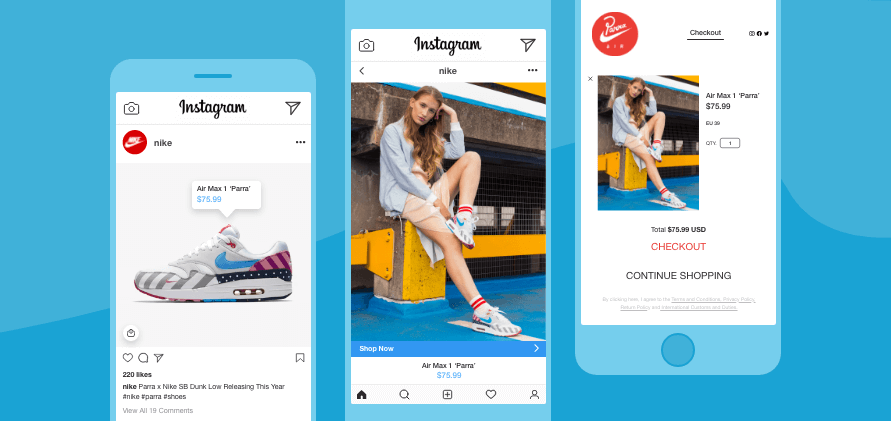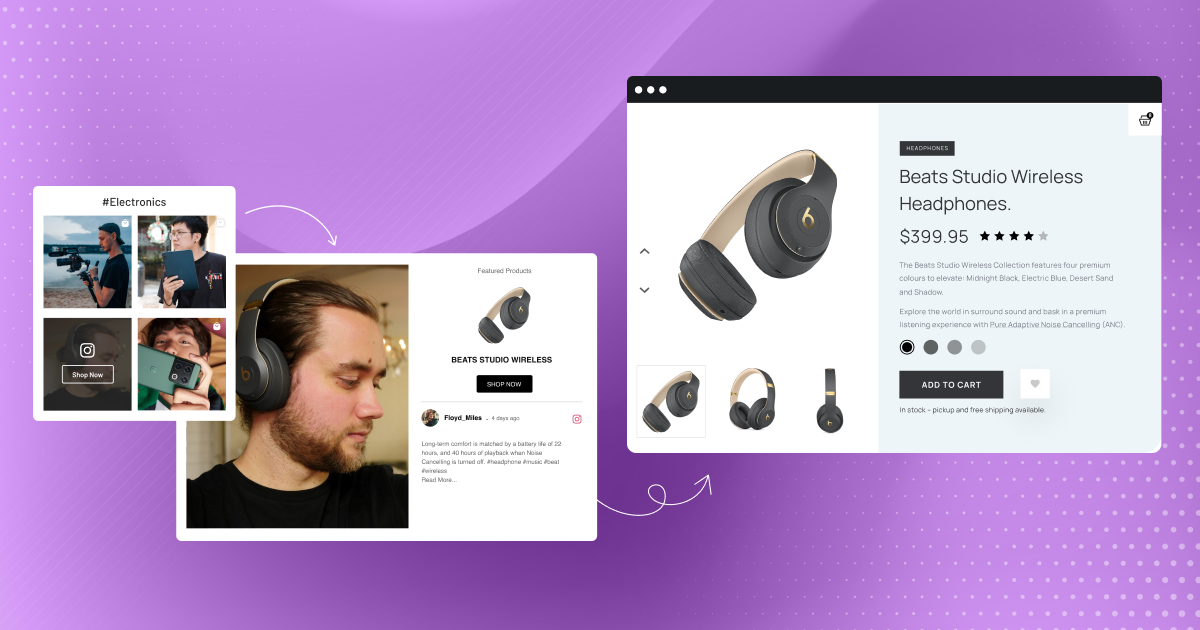What is Social Commerce? Top 10 Selected Platforms For Your Brand
Social commerce is the strategy for e-commerce businesses that can support them in instilling authenticity, establishing customer trust, and improving user experience.
How often do you search online for a product and get convinced to buy it without looking for customer pictures or testimonials? Almost never. And fairly so. Because trust is the most important aspect of any buying decision
How, you ask? By relying on efficient social commerce platforms that can seamlessly turn your social content into sales channels. However, there’s more to this strategy than meets the eye.
Let’s begin with the basics and learn the definition of social commerce. Gradually, we shall learn about future possibilities, trends, and benefits of social commerce.
What is the definition of Social Commerce in E-Commerce Landscape?
By definition, social commerce is a seamless blend of e-commerce and social media that allows businesses to use platforms like Instagram and Facebook to fetch content and use it for e-commerce functionalities, i.e., buying and selling.

Social commerce facilitates a seamless transaction between businesses and consumers. Be it product discovery or the checkout process, with social commerce in the picture, the whole e-commerce landscape becomes more engaging and interactive.
With this elaborative social commerce definition, you must be aware of what social commerce is. Now, let’s explore the best 10 social commerce platforms.
10 Social Commerce Platforms To Turn Social Into Sales
1. Instagram
With 1 billion active users, Instagram is undoubtedly the most effective social media platform for users, creators, and businesses.

Shoppable Instagram, for one, is an impressive feature for businesses that makes it easy for customers and brands to connect on the platform. Instagram has always offered visuals to engage users, and businesses are now using this to showcase their products and present themselves.
Shoppable Instagram is an in-app feature of the platform that allows the user to explore Instagram social commerce with features like and shop the Instagram feed without leaving the app. By tapping on the post, users get the name and price of the product. Then, they can navigate to the product detail page easily, and from there, users can check out without facing any distractions.
2. Facebook
Facebook is a social media giant and also one of the most beneficial social commerce platforms for businesses It has always amazed people with its unique features.

Even though social commerce is a relatively new concept, Facebook has always been a marketplace where businesses can sell products. With Facebook social commerce, businesses can create a social shopping store for their brand in just a few easy steps.
Facebook allows brands to customize their store free of cost. They can choose the product pictures they wish to showcase and select the theme to match their brand’s theme. These free-of-cost features from Facebook Shop allow small businesses to grow by connecting with their target audience anywhere, anytime.
3. Tagshop
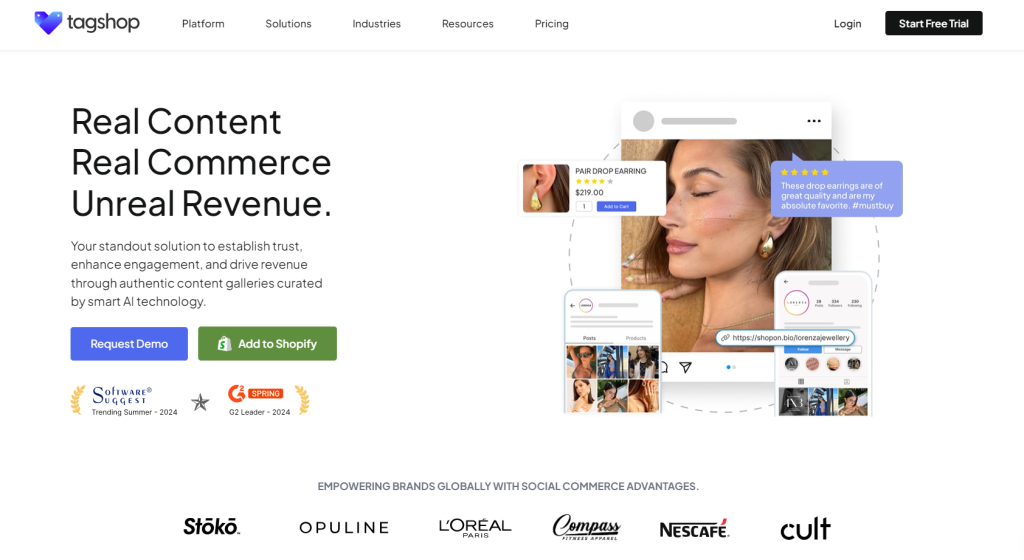
Tagshop is one of the most popular social commerce platforms that allow brands to turn their social content into brand sales.
With Tagshop social commerce functionalities, you can easily create shoppable galleries like shoppable Instagram feeds, shoppable UGC feeds, product page galleries, on-site UGC lookbooks, etc. It gives a social shopping experience to the visitors while staying on the website.
Authentic shoppable social galleries provide real-life experiences, attract users to explore your products, create brand engagement, and encourage customers to buy your product.
Tagshop keeps introducing new features to make the shopping experience fun. One such feature is Shopon.Bio. This feature allows businesses to create a shoppable social bio by curating content and creating a mini shop of social content. Users can paste this clickable and shoppable link into their Instagram or TikTok bio. This feature is important for brands looking to direct their sales on social media to their website.
Features that Solve Problems:
Advanced AI-Filters
Get Ai recommandation for each post
Easily Get UGC Rights
Send personalized request for ugc rights
Enable SnapUp
Collect social content directly from customers
Find content creator
Save time and get in touch with real content creators
Product Catalogue Management
Manage all products from one platform
Google Analytics & UTM Tracking
Setup Google analytics and track all conversions
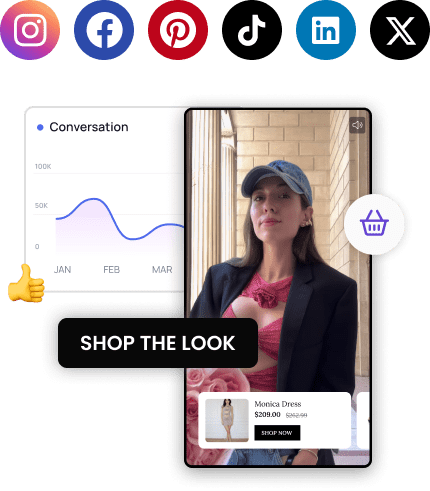
4. Snapchat
Snapchat is famous for its unique filters, which work with augmented reality, making the filters look very real. Although Snapchat has yet to become a social commerce platform entirely, it has partnered with Shopify, that allows brands to create unique filters showcasing their products.
Snapchat users can try these filters out if they wish to try the brands’ products. They can click the pictures and post them in their Snapchat stories. These pictures come with an embedded link to eCommerce’s website. The users can view the product, and their followers can also view it by clicking on the story. All this creates fun advertising opportunities for e-commerce brands.
5. YouTube
YouTube shopping enables brands to create videos and use them as catalogs to explore the products and buy them while staying on YouTube.
This feature will bring the customers closer to the brands as they would be directly dealing with them without any third party involved. Not leaving the site is one thing users don’t even have to pause or stop the video they can purchase while the video is still playing.
6. Pinterest

Pinterest has introduced buyable pins that allow users to buy products from posts created by brands on Pinterest. Like Instagram, Pinterest also focuses on the visuals. But the way they present their shoppable post is different.
The idea is to create a mobile-friendly, secure, and easy buying space, and Pinterest is already loved by 459 million of its monthly active users.
This new shoppable pin feature is a part of Pinterest social commerce and has helped brands increase sales, and businesses don’t have to create extra marketing strategies to influence users to visit their e-commerce website. It has also increased Pinterest’s dwell time as users don’t have to leave the app.
7. Amazon Live
Social e-commerce is something newly introduced by Amazon. With Amazon Live, brands are blending social shopping with influencer marketing. The ultimate goal is to generate traffic.
With the help of influencers in their network, brands create live videos showcasing these influencers using their products. Along with that, they also give discount coupons to the viewers.
It influences the viewers to buy the product. Their favorite influencers show them the use case of the product, and they also get discount coupons. Amazon Live creates brand engagement and increases sales opportunities.
8. Verint
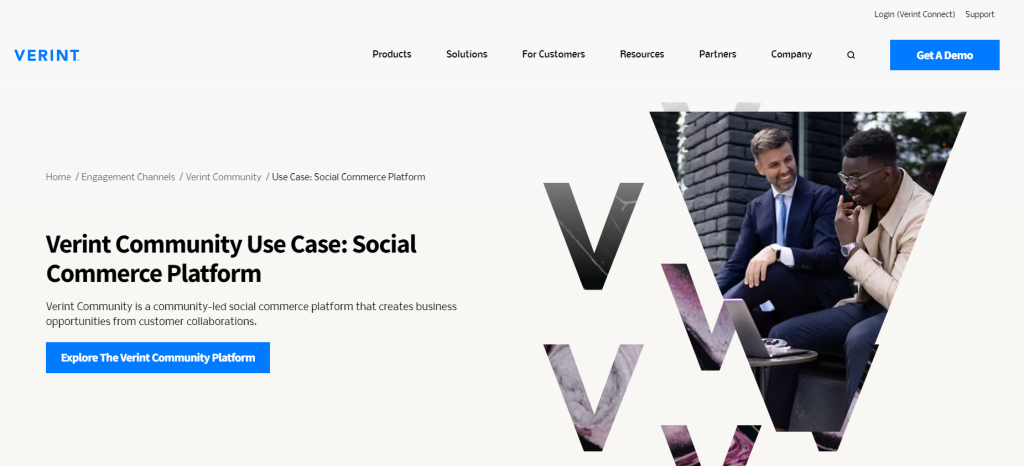
Verint Community provides a customizable social commerce platform to businesses that help them drive sales. It has the perfect customer insights that help you perform better and give better results to the target audience as per their requirements.
A unique feature by Verint is the open discussion forum that bridges the communication gap between the brand and its customers by creating one-on-one conversations and building brand trust.
9. Meesho

Meesho is a reselling app that has empowered many sellers and manufacturers to take their business online. It helps people to get recognition as entrepreneurs without any resources required. All you need is the Meesho app, a social media account where you can talk to buyers and share the products, and you are good to go.
Wholesalers post their products on Meesho at wholesale price, and Meesho users can share the pictures of these products with their network by adding their margin to the price tag.
Anyone who confirms the order with the user can place the order from the Meesho app and mention the total amount. The wholesale price goes to the wholesaler, and the margin price goes to the user. Meesho acts as a medium as it collects the product from the wholesaler and delivers it to the user’s customer.
10. Bazaarvoice
Like Tagshop, Bazaarvoice also revolves around using UGC to influence the target audience and build brand trust. They work between brands, shoppers, and retailers to provide smarter shopping experiences.
The idea is to build an easy connection with the shoppers to create brand awareness. They help e-commerce to optimize their website to provide a social shopping experience to the visitors and turn them into loyal customers.
Benefits of Social Commerce For Businesses
Social commerce is a top-tier strategy that offers an array of benefits to businesses. However, what’s noteworthy is that these benefits can be obtained solely through choosing a platform that serves you best.
In the previous section, we have provided you with a list of the top 10 social commerce platforms.
Now, let’s learn how social commerce platforms benefit businesses through their unique features.
1. Puts Your Social Content Into Use Efficiently
One way social commerce platforms benefit businesses is that social commerce allows businesses to leverage their social media content effectively for sales.
This includes product showcases, user-generated content, and promotional material. By integrating these elements into the shopping experience, businesses can turn their social media presence into a direct sales channel.
2. Improves Brand’s Visibility
Social commerce further improves brand visibility and expands a brand’s reach by tapping into the vast user bases of social media platforms.
As brands integrate social content into their landing pages, users feel more connected and in touch with the brand. This persuades consumers to create more content for your business, improving brand visibility.
3. Makes The Shopping Journey Smooth
Another way social commerce platforms benefit ecommerce businesses is by significantly improving the shopping journey of users.
By allowing users to discover and buy products through authentic social and user-generated content, users don’t have to navigating between pages. This reduces the number of steps in the customer journey, making it more convenient and increasing the likelihood of impulse purchases.
4. Builds Better Brand-Customer Relationship
Social commerce platforms enable direct interaction between businesses and customers. This direct line of communication allows for real-time engagement, addressing customer queries, and providing personalized recommendations.
By integrating customer content into e-commerce, businesses can build a sense of belonging among customers. This can lead to increased loyalty and repeat business.
5. Streamlines Content Management
Another impressive way in which social commerce platforms benefit businesses is by providing a centralized platform for managing and organizing product information. This streamlines content management by allowing businesses to update product details, pricing, and availability in real-time.
Additionally, integrating knowledge management solutions can further enhance this process by ensuring that all team members have access to up-to-date and relevant information.
Also, social commerce platforms often come with analytics tools that provide businesses valuable insights into customer behavior. This data can be used to optimize content aggregation even better.
Social commerce offers businesses the opportunity to set their social content in the spotlight and generate the maximum amount of returns from it. There are various platforms that provide unique functionalities and are contributing to the rise of social commerce in the near future.
The Evolution of E-Commerce and the Rise of Social Commerce
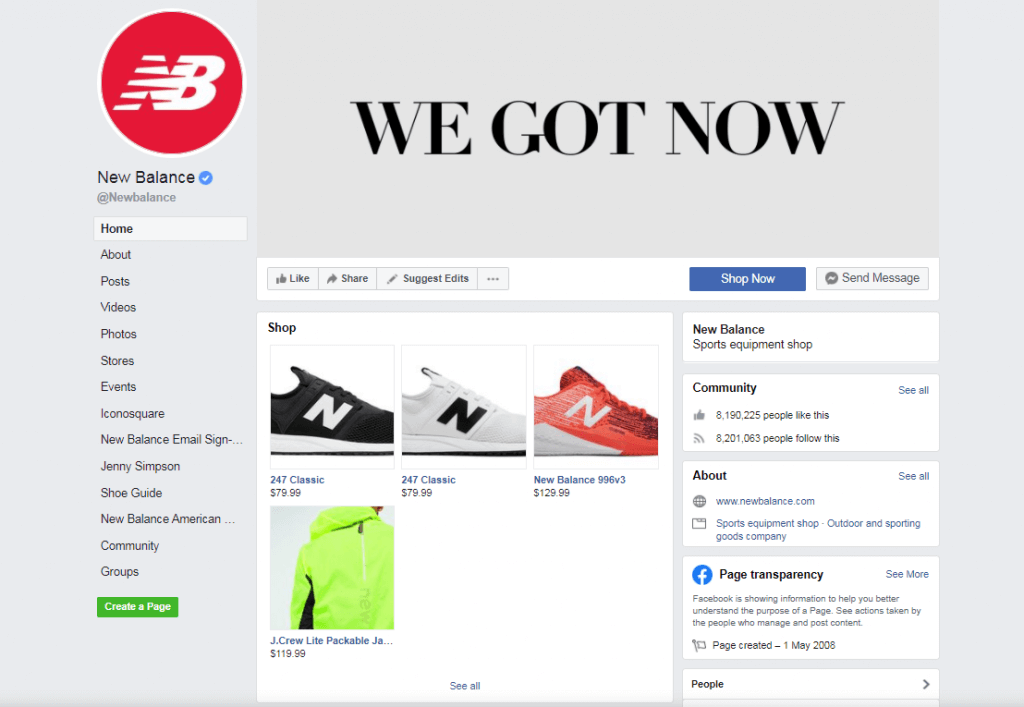
The evolution of e-commerce can be attributed to various factors and changes in consumer behavior. Unlike before, when online shopping had limited options, and fewer businesses offered online shopping services. Now, there are over 24 million e-commerce stores globally.
With such a sharp spike in the industry, change had to be owned. In comes the rise of social commerce – a type of commerce that’s more visual and more social.
The terms e-commerce and social commerce are quite intermingled and have many factors in common. However, they still differ from each other significantly.
Let’s find out.
Differentiating Between Social Commerce & Traditional E-commerce
Social commerce is a fairly new concept; however, its roots go back to the concept of e-commerce.
Despite their interwoven nature, each plays a unique role in the digital landscape. In this section, we will uncover both the concepts of social commerce vs. e-commerce.
| Social Commerce | Traditional E-Commerce |
| Integrates with social media platforms such as Facebook and Instagram easily for product discovery and purchase. | Relies on branded content and a dedicated online storefront for product display. |
| Emphasizes user-generated content, reviews, and social interactions to drive engagement and sales. | Relies on website design, product descriptions, and customer reviews for engagement. |
| Uses authentic customer or influencer content to promote products and leverage their audience for increased reach and credibility. | Uses traditional marketing techniques such as traditional advertising, print media, SEO, and email campaigns. |
| Offers a seamless purchase process with the ability to buy products directly through a social content feed integrated on the website. | Requires users to navigate between pages to reach the dedicated website or online store to complete a purchase. |
What Are Some Social Commerce Trends in 2024?
Social commerce has repeatedly proved its impact on the world. Speaking by numbers, an influencer’s shoutout about a product on Instagram can generate 200% more sales than a promotional poster on a retail store’s wall. That’s the power of prioritizing ‘social.’
Now, let’s talk about some trends in social commerce that are making this strategy top of all.
1. More Emphasis on Live Shopping
Live shopping is an upcoming social commerce trend that provides the opportunity for brands to connect with their audience in real-time.
This engagement goes beyond traditional e-commerce, allowing for instant feedback, questions, and product demonstrations, making shopping much quicker.
2. Integration of Augmented Reality
Another social commerce trend is integrating augmented reality into e-commerce. AR is transforming the online shopping experience by allowing users to virtually try on products or visualize them in their real-world environment.
This technology enhances the confidence of online shoppers by providing a more accurate representation of products.
3. More Gamification Elements
Gamification elements, such as rewards, challenges, and interactive features, make the social commerce experience more engaging and enjoyable for users. This approach not only captures attention but also encourages continued participation.
Additionally, gamification can be employed to create a sense of community among users. This community-building aspect contributes to brand loyalty and creates a positive customer experience.
4. More Gamification Elements
Gamification elements, such as rewards, challenges, and interactive features, make the social commerce experience more engaging and enjoyable for users. This approach not only captures attention but also encourages continued participation.
Additionally, gamification can be employed to create a sense of community among users. This community-building aspect contributes to brand loyalty and creates a positive customer experience.
5. Integration of Video Commerce
Video commerce is an emerging trend in social commerce that allows brands to tell compelling stories about their products and connect with audiences on an emotional level. The visual and auditory components of video content can convey information more immersive than static images or text.
Social Commerce 2024 Industry & Statistics
The past few years have been years of reformation for social media, the internet, and everything related. With 2024 beginning, we have these mind-blowing social commerce industry statistics to prove its certain growth in the coming years.

- According to research, US social commerce sales are anticipated to reach $916.84 billion by the end of 2026, with more than half of the country’s adults purchasing social media.
- Social commerce is expected to increase by 22.8% in 2024 and reach $1.2 trillion in 2025.
- 53% of global consumers say they intend to shop more through social platforms in the future.
In summary, the social commerce market size will only get larger, and brands should expand their selling channels to keep up with it.
Conclusion
Believe it or not, social media platforms have become the prime medium of connecting with people on a genuine note.
For businesses running on an eCommerce model, it’s time to catch up with the times and incorporate social commerce in their strategy. Brands are making the most of it, and there is no reason why you should stay behind.
We have reached the end of this blog, and you have learned about some of the top social commerce platforms and their benefits for your brand.
If you haven’t started building your social shopping account already, then be aware you might miss the train!
Frequently Asked Questions
Social commerce is a type of e-commerce that uses social media content as a front to showcase products. It allows businesses to integrate social content into their e-commerce store, enabling customers to buy products directly from the content itself.
Here are 10 best social commerce platforms.
Instagram Shop
Yotpo
Tagshop
Bazaarvoice
Facebook Shop
Pinterest
TikTok Shop
Snapchat
Meesho
Pixlee TurnTo
In 2024, some trends in social commerce include more emphasis on video commerce, integration of augmented reality, better mobile optimization, and hosting live shopping streams.

